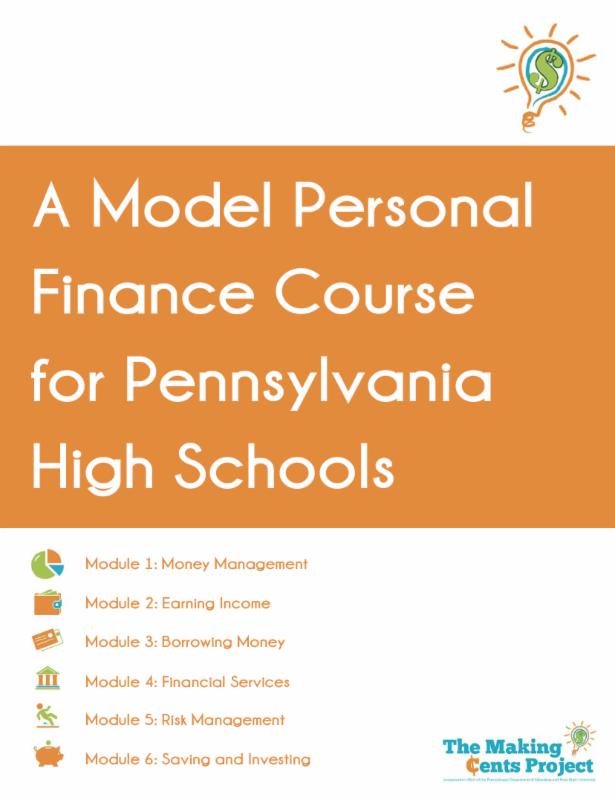| A Note from the Project Director |
|
While the weather may not have been the best indicator recently, summer is quickly approaching. In fact, my own children will be out of school in just a few days and many more will join them in the coming weeks.
Along with time to relax and regroup after a busy school year, the summer provides excellent opportunities to consider your approach to financial education and make plans for the upcoming school year.
In this edition, you'll find information to help you review or implement a high school personal finance course, be a pioneer and pilot a new resource for grades PK through 12, consider your own financial rules of thumb, and use current events to engage students year round.
If you are reviewing your financial education programs this summer and wish to have assistance, please do not hesitate to reach out. I'm happy to offer any assistance that I can. Also, in the coming school year, if you wish to schedule an in-person or virtual financial education training session, please be in touch. The Making Cents Project will be expanding its efforts this year and providing more local assistance.
Meanwhile, I extend my best wishes for a wonderful summer!
Hilary Hunt
|

|
|
 Model Personal Finance Course for Pennsylvania High Schools
|
Professional Resource
|
|
A team of Pennsylvania educators has developed an excellent tool for high school teachers that have or are starting a course in personal finance.
The Model Personal Finance Course for Pennsylvania High Schools provides a detailed framework for a standalone, one-semester course divded into six modules. The course can serve as either a "springboard" or a "ruler." Districts that are just starting to develop a course can use the course as a springboard or jumping off point and avoid countless hours trying to start from scratch. Meanwhile, schools with an established standalone or integrated course, can use the course as a means of comparing objectives and locating new instructional resources.
The course is available online through the Pennsylvania Department of Education's
Standards Aligned System (login required) or in
PDF form. If you need assistance in using the course, please contact Hilary Hunt with The Making Cents Project at
[email protected].
|
 |
|
 New Money Smart for Young People Curriculum New Money Smart for Young People Curriculum
|
Curriculum
Resource
|
|
The Federal Deposit Insurance Corporation (FDIC) has a new
Money Smart for Young People financial education program that features four standards-aligned curricula-for Grades Pre-K-2, 3-5, 6-8, and 9-12. Each set of lesson plans offers ideas for integrating financial education instruction into subjects such as math, English, and social studies. An inviting Parent/Caregiver Guide is also included.
Access the Resources
You can access the curriculum and videos that demonstrate how financial education concepts can be taught in the classroom
here.
Participate in a Pilot Program
The Society for Financial Education and Professional Development, Inc. (SFE&PD) served as the contractor for development of the new curricula. FDIC and SFE&PD are now in the implementation stage, which includes a pilot of the curriculum at selected schools around the country.
Teachers at grade levels Pre-K-2, 3-5, 6-8, and 9-12 are needed to pilot the curriculum during the 2016-2017 school year. The pilot will help FDIC and SFE&PD gain insights on the curriculum's implementation and inform the improvement of this product. Feedback will be gathered via surveys, conference calls, or webinars during the school year. SFE&PD will serve as a resource for the pilot teachers during the school year and help answer any questions about the curriculum.
Please contact Theodore R. Daniels (
[email protected]) or Susan Baudoin Bistransin (
[email protected]) of SFE&PD if you would like to participate in the pilot program or to schedule a group professional development program on the new Money Smart for Young People curriculum. They can also be reached at 703-920-3807.
|

|
|
|
|
Personal & Professional
Resource
|
Examples of common rules of thumb include "save ten percent of your income" and "pay down the loan with the highest interest rate first."
Research from the Consumer Financial Protection Bureau (CFPB) found that many consumers know about common financial rules of thumb, but few act on them. There is a gap between the rules of thumb and actual behavior. Finances are complicated and individualized, and the "right" decision can vary by person and circumstance, making one-size-fits-all rules difficult to identify.
In addition, the following resources could easily be adapted for classroom use:
Want to lear more about these Financial Rules of Thumb? Participate in a webinar this Thursday, May 26th at 2:00 or catch the recording afterwards. More information can be found here.
|

 |
|
 Financial News to Know Segments: Extending the Reach of Financial Education Financial News to Know Segments: Extending the Reach of Financial Education
|
Expand Your Knowledge
|
|
by Cathy Faulcon Bowen, Ph.D.
|
|

Recently there has been a flurry of activity on the legislative front related to personal finance and subsequently caused me to ask the questions, "Are personal finance educators weaving these current events into their classrooms and encouraging students to pay attention to financial news beyond the typical ups and downs of the stock market?" More importantly, "Are educators encouraging students to take actions within their control to influence the rules or laws as they are made?"
Why is this important when many students may not be directly impacted by the current financial news or are too young to legally vote? First, doing so will plant the seed that students' financial security in life will be impacted not only by the daily choices they make but also by the laws that govern our financial markets. In order to make decisions that ultimately influence their bottom line and financial security, students must constantly be consumers of financial information in the news and pay attention to news items that have implications for their personal financial situation.
Three financial topics recently in the news include: 1) changes in the Social Security system that impacts the way retirees withdraw Social Security income, 2) the Department of Labor's rule to require retirement advisors to put the interest of their clients first, and 3) proposed legislation to simplify the tax code.
None of the above three items are likely to make high school students' top ten list of things to talk about on social media or for that matter in personal conversations. However, they can be used as Financial News to Know segments, that is, as an attention getter at the beginning of a class.
Changes in Social Security
For example, reminding students who will work summer jobs not to be surprised by the Social Security (6.20%) and Medicare (1.45%) taxes that will be deducted from their earnings each paycheck prepares them for their smaller than expected take home pay. In addition, you could mention that there are several ways to withdraw Social Security income (which is based on the taxes they pay) at retirement. A recent Social Security change, the elimination of
file and suspend rules
, reduces a strategy married couples used to maximize the income received from Social Security. Yet there are other ways to take Social Security benefits at retirement. A key to maximizing this benefit at retirement will be understanding your options well before your retirement date. Students could receive a simple fact sheet with the Social Security and Medicare rates calculated on a pay stub and links to www.ssa.gov with
booklet
titles related to Social Security benefits. Challenge students to talk to their parents about Social Security and thereby raise parents' awareness of recent changes and options for taking Social Security benefits.
Department of Labor's Fiduciary Responsibility Ruling
Another Financial News to Know item is the Department of Labor's recent rule regarding the fiduciary responsibilities of retirement advisors. This rule requires advisors to put the financial interest of their clients first. You can discuss the process---how the initial announcement of the proposed changes by
President Obama on February 23, 2015
led to the final rule issue by the
Department of Labor on April 6, 2016.
This final rule had many steps including a time for public comment that consumers and retirement advisors could share their perspectives on the proposed rule.
Simplifying the Tax Filing Process
Finally, the most recent item, a bill introduced by
Senator Elizabeth Warren to simplify the tax filing process
for millions of taxpayers. Officially called the
Tax Simplification Act of 2016
, this nine-page bill provides an opportunity for every taxpayer to voice their opinion and to influence an outcome that impact their bottom line. The
timing of the bill
is just after the close of the 2016 filing season, while the tax filing process is fresh on the minds of millions. It presents an opportunity to involve students in a process they can track from beginning to end.
Background information
about the bill helps to frame the rationale for the bill. Consider having students research this - or other legislation with a financial impact - and formulate their own opinions. Hosting a debate in class would further deepen students' understanding and make them think about the issue from multiple points of view.
Our daily choices and decisions influence our bottom line. However, the decisions we make are governed in part by laws and regulations related to personal finances. Consumers have an opportunity to influence the laws and regulations affecting our bottom line. The questions are: 1) Are we aware of these issues and 2) Are we doing what we can to influence the decisions that will ultimately affect our bottom line? As teachers, you are uniquely positioned to influence the thinking, habits, and actions of future generations. Are you?
|
Have you missed a message from us in the past? Get caught up! Visit our archive of previous Making Cents eBlasts
here.
|
|
Making Cents is a cooperative effort by the Pennsylvania Department of Education and the Pennsylvania State University. If you find the content useful, please consider forwarding it to your colleagues.  
Team Members: Sally Flaherty, PDE Cathy F. Bowen, PSU Hilary Hunt, The Making Cents Project |
|